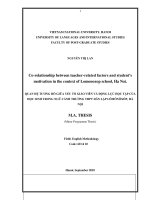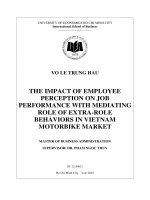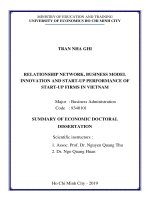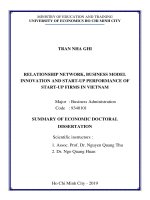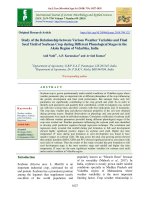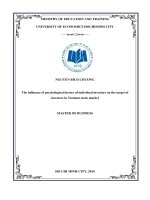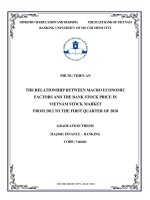The relationship between macro economic factors and the price index of bank stocks price in vietnam stock market
Bạn đang xem bản rút gọn của tài liệu. Xem và tải ngay bản đầy đủ của tài liệu tại đây (1.68 MB, 91 trang )
MINISTRY OF EDUCATION AND TRAINING
THE STATE BANK OF VIET NAM
BANKING UNIVERSITY OF HO CHI MINH CITY
PHUNG THIEN AN
THE RELATIONSHIP BETWEEN MACRO ECONOMIC
FACTORS AND THE BANK STOCK PRICE IN
VIETNAM STOCK MARKET
FROM 2012 TO THE FIRST QUARTER OF 2018
GRADUATION THESIS
MAJOR: FINANCE – BANKING
CODE: 7340201
-
HO CHI MINH CITY, MAY 2018
HO CHI MINH CITY - 2018
MINISTRY OF EDUCATION AND TRAINING
THE STATE BANK OF VIET NAM
BANKING UNIVERSITY OF HO CHI MINH CITY
PHUNG THIEN AN
THE RELATIONSHIP BETWEEN MACRO ECONOMIC
FACTORS AND THE BANK STOCK PRICE IN
VIETNAM STOCK MARKET
FROM 2012 TO THE FIRST QUARTER OF 2018
GRADUATION THESIS
MAJOR: FINANCE – BANKING
CODE: 7340201
INSTRUCTOR
M.S. LIEU CAP PHU
HO CHI MINH CITY - 2018
BANKING UNIVERSITY OF HO CHI MINH CITY VIETNAM
High-Quality Program of Banking and Finance
ABSTRACT
Author
AN, Thien PHUNG
Title
The relationship between macro-economic factors and bank stock
price in Vietnam stock market from 2012 to the first quarter of 2018
Year
2018
Language
English
Supervisor
PHU, Cap LIEU
In the current overall development of the economy, the role of analyzing the effects of
macroeconomic factors is indispensable in order to figure out viable remedies to retain
the sustainable growth of the country’s economic system. One of the most concerns of
the public is the stability and development of the stock market. In this thesis, the author
chooses to show deep insight into the relationship between four macroeconomic criteria
including Exchange rate, Money supply M2, Inflation rate and short-term lending
interest rate and the bank stock price in the Vietnam stock market. Assumptions are
Inflation rate, Exchange rate and Short-term interest rate have a reverse correlation to
the bank stock price whereas Money supply M2 observes an opposite pattern.
Results indicate that all assumptions are favorable and the author also analyses all factors
in more details through graphs, showing the fluctuations in each criteria in bank stock
price. Last but not least, this study could partly contribute to the research of relevant
issues in stock market and provide a little necessary information for the future
experiments.
Key words: Inflation rate, Money supply M2, Exchange rate, Short-term lending rate,
Bank stock price
ĐẠI HỌC NGÂN HÀNG THÀNH PHỐ HỒ CHÍ MINH
Chương trình Cử nhân Chất lượng cao – Chuyên ngành Tài chính Ngân hàng
TÓM TẮT
Sinh viên thực hiện
Phùng Thiên Ân
Tên đề tài
Mối quan hệ giữa các yếu tố vĩ mô và giá cổ phiếu ngành
ngân hàng trên thị trường chứng khoán Việt Nam giai đoạn
2012-quý 1/2018
Năm thực hiện
2018
Ngôn ngữ
Tiếng Anh
Giảng viên hướng dẫn
Ths. Liêu Cập Phủ
Trong sự phát triển chung của nền kinh tế, vai trò của việc phân tích tác động của các
yếu tố kinh tế vĩ mô là không thể thiếu để tìm ra các biện pháp khả thi nhằm duy trì sự
phát triển bền vững của hệ thống kinh tế của đất nước. Một trong những mối quan tâm
nhất chính là sự ổn định và phát triển của thị trường chứng khoán. Trong luận án này,
tác giả chọn phân tích về mối quan hệ giữa bốn tiêu chí kinh tế vĩ mô bao gồm tỷ giá,
cung tiền M2, tỷ lệ lạm phát và lãi suất cho vay ngắn hạn đến giá cổ phiếu ngân hàng
trên thị trường chứng khoán Việt Nam. Tác gải đặt ra giả định là tỷ lệ lạm phát, tỷ giá
hối đoái và lãi suất ngắn hạn có sự tương quan nghịch với giá cổ phiếu ngân hàng trong
khi cung tiền M2 có tác động cùng chiều đến giá cổ phiếu ngành ngân hàng.
Kết quả cho thấy rằng tất cả các giả định đều thuận lợi và tác giả cũng phân tích tất cả
các yếu tố chi tiết hơn thông qua biểu đồ, cho thấy sự biến động trong từng tiêu chí trong
giá cổ phiếu ngân hàng. Cuối cùng nhưng không kém phần quan trọng, nghiên cứu này
một phần có thể góp phần vào việc nghiên cứu các vấn đề liên quan trên thị trường chứng
khoán và cung cấp những thông tin cần thiết cho các nghiên cứu trong tương lai.
Từ khóa: Tỷ lệ lạm phát, Cung tiền M2, Tỷ giá hối đoái, lãi suất tiền gửi ngắn hạn, giá
cổ phiếu ngành ngân hàng.
ii
DECLARATION
I, Phung Thien An, declare that this minor thesis on “The relationship between macroeconomic factors and bank stock price in Vietnam stock market from 2012 to the first
quarter of 2018” is a presentation of my original research work. Whether contributions
of others are involved, every effort is made to illustrate this clearly, with the reference
to the literature, and acknowledgement of collaborative research and discussions.
The thesis is for the partial fulfilment of the requirement for the degree of Bachelor of
Banking and Finance, and it is an original work.
It has not been summited earlier, either partly or wholly to any other University or
Institution has not been published in any other journal or magazine.
The work was done over the guidance of Lieu Cap Phu, MA at Banking University of
Ho Chi Minh, Vietnam.
[Author’s name and signature]
iii
ACKNOWLEDMENTS
I would first like to appreciate my thesis advisor Ms. Lieu Cap Phu of the Banking
Faculty at Banking Ho Chi Minh City. The door to Ms. Phu’s office was always open
whenever I ran into a trouble spot or had a question about my research or writing. She
persistently and consistently allowed this paper to be my work but steered me in the right
direction whenever she thought that it was of essence for me.
She has been the ideal thesis advisor. Her previous advice, insightful criticisms, and
gentle encouragement aided the writing of this thesis in countless ways.
I take this opportunity to express gratitude to all of the High-Quality Program
Department members for their great assistance. I would also like to thank my friends for
accepting nothing less than excellence from me.
Last but not least, I must express my profound gratitude to my family, especially my
parents for providing me with unfailing support and perpetual encouragement
throughout my years of study and through the process of researching and writing this
thesis. This accomplishment would not have been possible without them.
I also place on record, my sense of gratitude to one and all, who directly or indirectly,
have given their hand in this venture.
Wholeheartedly appreciate for all your stimulation and encouragement.
iv
TABLE OF CONTENT
ABSTRACT .............................................................................................................................................. i
TÓM TẮT ................................................................................................................................................ ii
DECLARATION .................................................................................................................................... iii
ACKNOWLEDMENTS ......................................................................................................................... iv
LIST OF CHARTS ................................................................................................................................ vii
LIST OF FIGURES .............................................................................................................................. viii
LIST OF APPENDICES ....................................................................................................................... viii
ABBREVIATIONS ..................................................................................................................................x
CHAPTER 1: THE OVERVIEW OF THE THESIS ................................................................................1
1.1.
Research background .............................................................................................................1
1.2.
Purpose of research .................................................................................................................2
1.3.
Significance of research ..........................................................................................................3
1.4.
Object and scope of the study ................................................................................................3
1.5.
Research questions ..................................................................................................................4
1.6.
Research methods....................................................................................................................4
1.7.
Structure of the themes ...........................................................................................................5
CONCLUSION OF CHAPTER 1 .............................................................................................................7
CHAPTER 2: AN OVERVIEW OF SYSTEMATIC RISK AND MACROECONOMIC FACTORS
AFFECTING STOCK PRICES IN THE BANKING SECTOR...............................................................8
2.1. Systemic risk and factors that create systemic risk in stock investment .................................8
2.1.1. Risks .......................................................................................................................................8
2.1.2. Systematic risk in stock investment .....................................................................................9
2.2. Review of literature ....................................................................................................................10
2.3. Macro-economic factors affect the price of bank stock ..........................................................15
2.3.1. Inflation rate ........................................................................................................................15
2.3.2. Money supply M2 ................................................................................................................15
2.3.3. Exchange rate (USD/VND) .................................................................................................16
2.3.4 Short-term interest rate .......................................................................................................16
CONCLUSION OF CHAPTER 2 ...........................................................................................................17
CHAPTER 3: RESEARCH METHODS AND DATA BASIS ..............................................................18
3.1 Description of variables ..............................................................................................................18
3.1.1 Dependent variable ..............................................................................................................18
3.1.2 Independent variable ...........................................................................................................18
v
3.2 Methods for data processing and proposed research methods ...............................................21
3.2.1. Methods for data processing ..............................................................................................21
3.2.2. Research methods................................................................................................................22
CONCLUSION CHAPTER 3 .................................................................................................................25
CHAPTER 4: RESEARCH RESULTS ..................................................................................................26
4.1. Descriptive Statistics ..................................................................................................................26
4.2. Measured results by ADRL model ...........................................................................................30
4.2.1. Unit-root Test ......................................................................................................................31
4.2.2. Latency selection for ARDL model....................................................................................33
4.2.3. Bound Test ...........................................................................................................................34
4.2.4. Model estimation in the long run .......................................................................................35
4.2.5. Short-term model estimation .............................................................................................37
4.2.6. Defects verification of the model ........................................................................................38
4.2.7. Stability test of the model ...................................................................................................39
4.2.8. Granger causality test .........................................................................................................41
4.3. Overview of the results ..............................................................................................................42
4.3.1. Money Supply M2 ...............................................................................................................42
4.3.2. Exchange rate ......................................................................................................................43
4.3.3. Inflation rate ........................................................................................................................43
4.3.4. Short-term interest rate ......................................................................................................43
CONCLUSION OF CHAPTER 4 ...........................................................................................................44
CHAPTER 5: CONCLUSIONS AND RECOMMENDATIONS ..........................................................45
5.1. Summary of the research...........................................................................................................45
5.2. Contributions of the research ...................................................................................................46
5.2.1. Research contributions and its significance ......................................................................46
5.2.2. Recommendations for investors, bank executives and policy makers ............................46
5.3. Limitations of research and suggestions for future research .................................................48
CONCLUSION OF CHAPTER 5 ...........................................................................................................51
GENERAL CONCLUSION ...................................................................................................................52
REFERENCES........................................................................................................................................53
vi
LIST OF CHARTS
Chart 4.1: Descriptive statistics of variables ................................................................. 25
Chart 4.2: Fluctuations in LM2 and LG ........................................................................ 26
Chart 4.3: Fluctuations in Exchange rate and Bank Stock Price .................................. 27
Chart 4.4: Fluctuations in Inflation rate and Bank Stock Price .................................... 27
Chart 4.5: Fluctuations in Short-term interest rate and Bank Stock Price .................... 29
Chart 4.6: Unit-root Test on variable ............................................................................ 31
Chart 4.7: The critical value of Unit-root test ............................................................... 31
Chart 4.8: ARDL Model (1,0,0,1,1) .............................................................................. 33
Chart 4.9: Long-term Relationship Test ....................................................................... 34
Chart 4.10: Long-term Coefficient................................................................................ 35
Chart 4.11: Short-term Coefficient ............................................................................... 36
Chart 4.12: The variables are statistically significant in the short run.......................... 36
Chart 4.13: Causality tests............................................................................................. 38
Chart 4.14: Results of Granger Causality Test ............................................................. 40
vii
LIST OF FIGURES
Figure 4.2: Top 20 models according to AIC ............................................................... 33
Figure 4.3: CUSUM Test about stability in the model………………………………..39
Figure 4.4: CUSUM square Test in stability in the model............................................ 39
LIST OF APPENDICES
Appendix 1 ADF Test ...................................................................................................... I
ADF Test for LG at I(0) ............................................................................... I
ADF Test for LG at I(1) ............................................................................. II
ADF Test for LM2 at I(0).......................................................................... III
ADF Test for LM2 at I(1) .......................................................................... IV
ADF Test for LER at I(0) ........................................................................... V
ADF Test for LER at I(1) .......................................................................... VI
ADF Test for LLP at I(0)..........................................................................VII
ADF Test for LIR at I(0) ........................................................................ VIII
Appendix 2 PP Test ....................................................................................................... IX
PP Test for LG at I(0) ................................................................................ IX
PP Test for LG at I(1) ................................................................................. X
PP Test for LM2 at I(0) ............................................................................. XI
PP Test for LM2 at I(1) ............................................................................XII
PP Test for LER at I(0) ........................................................................... XIII
PP Test for LER at I(1) ........................................................................... XIV
PP Test for LLP at I(0) ............................................................................ XV
viii
PP Test for LIR at I(0) ........................................................................... XVII
Appendix 3 Latency Selection in Ardl Model ........................................................ XVIII
Appendix 4 Bound Test .......................................................................................... XVIX
Appendix 5 Short-term and Long term relationship between criteria ........................ XX
Appendix 6 LM Test .................................................................................................. XXI
Appendix 7 Ramsey Test .......................................................................................... XXII
Appendix 8 Breusch-Pagan-Godfrey Test .............................................................. XXIV
Appendix 9 Granger Causality Test ......................................................................... XXV
ix
ABBREVIATIONS
ADF
Augmented Dickey-Fuller
APT
Arbitrage Pricing Theory
ARDL
Autoregressive Distributed Lag
BIDV
Bank for Investment and Development of Vietnam
CAPM
Capital Assets Pricing Model
CPI
Consumer Price Index
CUSUM
Cumulative Sum Control Chart
DCF
Discounted Cash Flow
ECM
Error Correction Model
GDP
Gross Domestic Product
GICS®
Global Industry Classification Standard
HOSE
Ho Chi Minh City Stock Exchange
HNX
Hanoi Stock Exchange
ICB
Industry Classification Benchmark
IFS
International Financial Statistics
IMF
International Monetary Fund
OLS
Ordinary Least Squares
PP
Phillips-Perron
SBV
State Bank of Vietnam
VAR
Vector Auto regression
VACM
Vietnam Asset Management Company
VECM
Vector Error Correction Model
x
CHAPTER 1: THE OVERVIEW OF THE THESIS
1.1. Research background
The stock market is an effective way to raise capital. Since its inception and
development, it has played an indispensable role in the operation and development of
the economy. In some rapidly growing stock markets such as New York, London,
Japan… besides helping capital to flow quickly, the stock market is also a good
investment place for many organizations and individuals to participate and seek profit in
the market as well. In Vietnam, although the market has been operating since 2000, it is
relatively new compared to other stock markets in the world. However, over the past 15
years, Vietnam stock market has been increasingly improving and expanding.
In the process of development of the economy, the circulation of capital on the
stock market contributes to making the production machinery operate smoothly when
participating in securities investment in the market more attractive. All investment
decisions are considered in terms of risk and expected return. Stock prices are heavily
affected by a variety of risk factors, including systemic risk and non-systemic risk. Stock
valuation is an urgent and necessary task in the current period, when the stock market in
particular and the Vietnamese economy is still backward compared to the general
development of the stock market all over the world.
To determine the correlation between the stock market and the risks, there are
many different measures. In some countries where financial markets have developed,
investors have been able to apply modern financial investment theories to select stocks
within their portfolio based on two broad spectrum models namely CAPM and APT. The
rate of return on securities will be determined by the risk that the stockholder is subjected
to, and can be determined by the multiple regression method. Depending on the views
and perceptions, each investor or researcher will put different variables into the research
model. The later methodology contributes to improve and overcome the disadvantages
that previous methods encountered.
1
Banking is a key industry and plays a crucial role in the economy. It is also one
of the riskiest sectors, especially systematic risk and non-systematic one. On the global
scale, the most recent global economic crisis of 2007-2008 has raised the concern as well
as has posed a strong influence of the banking industry to the market. In the Vietnamese
market, after witnessing a period of instability, the economy is gradually recovering.
Since, the banking sector has experienced positive changes, the ratio of foreign exchange
reserves has been constantly improving and by the end of 2017, it has reached nearly 52
billion USD. In addition, resolution 42 on dealing with bad debt, which came into force
on 15 August 2012, is an important legal document because for the first time, legal issues
related to the handling of bad debts and assurance of debts has lasted for many years and
have grounds for settlement. Particularly, over the past three years, from 2015 to 2018,
banks have been massively racking up the stock market and the banking sector has been
increasing significantly and affecting the VN Index. Is there any risk behind the rapid
development? And do macroeconomic policies have a significant impact on the banking
sector? Therefore, studying the macro factors affecting the risk of the banking sector is
essential. Based on that, the writer chose the topic “The relationship between macroeconomic factors and bank stock price in Vietnam stock market from 2012 to the
first quarter of 2018”.
1.2. Purpose of research
Systematizing issues related to systemic risk in stock investment and providing
an overview of price fluctuations in banking stocks.
Identifying systemic risks from the macro-economy that affects the stock price
index on the Vietnam stock market in general and banking sector in particular.
Case study of the ARDL model will identify the macroeconomic factors affecting
the banking sector in the Vietnamese stock market, the long-run equilibrium relationship
between the banking sector price index and the systematic risk of the market.
2
Summarizing the effect of systematic risk factors on the stock price index of
banking sector and supposing some recommendations for investors, managers and the
government in managing this field.
1.3. Significance of research
Modern econometric models are increasingly popular used by many investors in
this field such as OLS, VAR, VECM, etc. When the time series data does not stop at I
(0), OLS regression will be easy to fall into the fake regression, resulting in inaccurate
model test results. VAR and VECM are only applicable when time series integrate at the
same level without enabling integrated data at different levels. Meanwhile, ARDL allows
regression with integrated time series data at both I (0) and I (1). In Vietnam, there have
been many empirical studies to explain the relationship between price and macro factors
affecting stock prices, the VN-Index, but currently, very few empirical studies are
specific to the banking sector. The study also showed the long-run equilibrium
adjustment factor (ECM) of the ARDL equation for the banking sector index, thus taking
into account short-term patterns. This research is not only meaningful for investors,
securities analysts, but also for banks to identify the factors that can influence their
performance. Besides, it also helps the government to implement favorable policies. The
study also opens up a number of suggestions for future studies.
1.4. Object and scope of the study
Research object: Systematic risk factors impact the stock price of the banking
sector in Vietnam stock market from 2012 to the first quarter of 2018.
Research scope: The topic is limited to studying the use of the ARDL model to
determine the relationship between macroeconomic factors and the price index of
banking stocks in the Vietnam stock market, from January 2012 to March 2018. The
market data includes interest rates, inflation rates, exchange rates and money supply
according to the monthly data released by the General Statistics Office of Vietnam and
the cophieu68.com, cafef.com, banks the State Bank of Vietnam (SBV), the Foreign
Investment Department, and the International Monetary Fund (IMF).
3
1.5. Research questions
The study aims to answer two questions, thus drawing conclusions about the
short- and long-term relationship between the banking sector stock price index and
variables:
-
Are the systematic risk factors in the market really affecting the price of stocks in
the banking sector on the stock market in Vietnam?
-
Are there long-term relationships between macroeconomic factors and the
banking sector price index?
There are many studies in the world that show that stock prices are strongly
impacted by macroeconomic factors in the market. Therefore, is the banking industry in
Vietnam affected by these factors or not, and if so, what is the impact on banking sector
stocks?
1.6. Research methods
The research was analyzed by the method of collecting historical data published
in mass media, data sources provided by the Government in combination with methods
of comparison, analysis, Statistics, using illustrative charts to give comments on the
practicality of theory when applied in the Vietnam market.
+ Description statistics:
Statistics of the macro risk factors required for the topic from the
information pages published by the statistical office, cafef.com, cophieu68,
vietstock ...
+ Model building:
The study uses the ARDL regression model to determine the regression
coefficients of the factors affecting the stock price index of the banking sector,
thereby identifying the extent of impact of macro factors on bank stocks as well
as finding the equilibrium equation in the long run between the variables
introduced into the model.
4
Evaluate the suitability of the model and the limitations of the research
model: including basic modeling, such as self-correlation testing, variable error
variance. At the same time, the use of the ARDL regression model also requires
the stability of the regression model. These will be the basis for determining the
results that the model gives.
1.7. Structure of the themes
Chapter 1: Overview
Chapter 1 will summarize the urgency of the topic, the research objectives, and
supply the research questions. This chapter also summarizes the scope and subject matter
of the research as well as the scientific, practical and research contributions.
Chapter 2: An overview of systematic risk and macroeconomic factors affecting stock
prices in the banking sector
In Chapter 2, the writer introduces the systematic risk of the stock and the
relationship between risk and stock price. This chapter will also present an overview of
the banking market, characteristics, types, and macroeconomic risks that affect the
banking industry. In addition, it also reviews the results of research in the world and in
Vietnam related to determining the relationship between macro factors and the stock
market.
Chapter 3: Research methods and databases
In this chapter, the writer will analyze in detail the research database, the variables
included in the model, the reasons for using the variables, and the expectations about the
variability of the independent variables on dependent variable ones. It will also outline
methods of data collection, processing, and statistical hypothesis testing and regression
models.
5
Chapter 4: Research results
This chapter will summarize the results of the model study presented in Chapter
3. Specifically, it will analyze the macroeconomic factors affecting the price index of
listed banks through regression model with ARDL.
Chapter 5: Conclusion and recommendations
Chapter 5 will draw conclusions about the relationship between the sector price
index and the systematic risk of banking sector stocks, assessing the impact of factors
on the stock price index. Simultaneously, the results of the study will suggest to investors
the establishment of effective portfolio and recommendations for the bank administrator
as well as the state bank to develop effective strategies. The last part of Chapter 5 also
outlines the limitations of the paper and suggests future research.
6
CONCLUSION OF CHAPTER 1
Banking plays a very important role in the market economy, directly related to a great
asset in both size and value. The reality is that the volatility of the economy is greatly
influenced by changes in the banking system. Therefore, research into the risks to the
industry is urgent, an indispensable need to be concerned, in order to adjust policies
accordingly. Chapter 1 highlights the urgency as well as the basics and novelty of the
research topic, summarizing what will be presented in the next chapters. Thus, the reader
can cover the essence of the article in this chapter.
7
CHAPTER
2:
AN
OVERVIEW
OF
SYSTEMATIC
RISK
AND
MACROECONOMIC FACTORS AFFECTING STOCK PRICES IN THE
BANKING SECTOR
2.1. Systemic risk and factors that create systemic risk in stock investment
2.1.1. Risks
2.1.1.1. Definition of risks
On a global scale, there are many numerous approaches and notions on risk. Risk
– according to Frank Knight (2012) is the mishaps related to unexpected upheavals, or
risk is the uncertainty associated with unintended events. Meanwhile, Athur William, Jr.
Michael, L. Smith (1998) indicate that: "Risk is implicit in the result. Risk mostly
originates human activities. When there is a risk, outcomes and repercussions are
unpredictable. The presence of risk causes uncertainty. Risk occurs whenever an action
leads to the possibility of being lost, unforeseeable."
Hence, in brief, in the author's perspective the risk is uncertainty and inevitability
in the future. Last but not least, it could be predictable or unpredictable, positive or
negative.
2.1.1.2. Risk classification
Risks are organized based on different criteria, origin of risk, operational
environment, industry, risk characteristics ... When it comes to the analysis on stock
market, the kind of risk that should be concerned is market risk. This risk could be
divided into 2 types:
+ Interest rate: the risk of adverse effects on the financial result and capital of the bank
caused by changes in interest rates.
+ Foreign exchange risk: the risk of adverse effects on the financial result and capital
of the bank caused by changes in foreign exchange rates.
+ A particular type of market risk is the risk of change in the market price of securities,
financial derivatives or commodities traded or tradable in the market.
8
Additionally, based on the profit or loss, risks could be categorized into two types,
namely speculative risk and static risk
+ Static risk: the risk associated with situations that may or may not occur.
+ Speculative risk: a situation where there is both a possibility of loss and gain.
Based on the nature of whether or not they can be diversified, risks are classified
into two categories: systematic risk and non-systematic risk.
+ Systematic risk: the risk inherent to the entire market or market segment, and it can
affect a large number of assets.
+ Non-systematic risk: this type of risk refers to the uncertainty inherent in a company
or industry investment.
In stock investment, any stock that is likely to suffer huge losses is considered to
be potentially risky. In the paper, the writer will go in the direction of the second
classification, and more in-depth analysis of systemic risk from the macroeconomic
factors that affect the price, thereby afflicting the rate of return of the stock.
2.1.2. Systematic risk in stock investment
In addition to the expected return on investment, investors have also interest in
issues related to financial risk. As aforementioned, financial risk includes two types
namely systematic risk and non-systematic risk. For non-systematic risk, investors can
easily eliminate risky cases if they know how to diversify the portfolio in a proper
manner. Nonetheless, in terms of systematic risk, no matter how the investors diversify,
this kind of risk could not be eliminated, with the exception for the case of diversifying
portfolios in different countries. There are various factors that cause systematic risks,
ranging from macro factors, politics, law, natural disasters, and the environment as well.
But in stock investment, there are major systemic risks, comprising:
-
Interest rate risk: the risk that an investment's value will change due to a change
in the absolute level of interest rates, the spread between two rates, in the shape
of the yield curve or in any other interest rate relationship. This type of risk affects
9
the value of bonds more directly than stocks and is a significant risk to all
bondholders. As interest rates rise, bond prices fall – and vice versa.
-
Foreign-exchange risk: the financial risk of an investment's value changing due
to the changes in currency exchange rates. This also refers to the risk an investor
faces when he needs to close out a long or short position in a foreign currency at
a loss, due to an adverse movement in exchange rates.
-
Inflation risk: this risk arises from the decline in value of securities cash flow due
to inflation, which is measured in terms of purchasing power.
-
Price risk is the risk of a decline in the value of a security or a portfolio that can
be minimized through diversification, unlike market risk. It is lower in stocks
with less volatility such as blue-chip stocks. Investors can use a number of tools
and techniques to hedge price risk, ranging from relatively conservative decisions
such as buying put options to more aggressive strategies including short selling
and inverse ETFs.
Furthermore, there are many contributing factors leading to systematic risk in
stock investment such as the impacts of gold price, world oil price, psychological effects,
human behaviors ... but the risks mentioned above are the risk that investors often
encounter. These risks affect the price, thereby influencing the rate of return of investors.
2.2. Review of literature
Paul & Mallik (2001) studied long-term relationships between macroeconomic
factors and stock prices in the Australian banking and financial sector. They used the
ARDL model to investigate causal relationships between the banking sector, the
Australian stock market index and financial indicators with macroeconomic variables
including consumer price index (CPI), interest rates and GDP adjusted seasonally. The
results show that interest rates have the opposite effect when GDP growth has the same
impact on banking stocks. Inflation had no significant effect in this study.
Vaz, Ariff & Brooks (2008) studied the effects of publicly disclosed official
interest rates on the yields of shares of major Australian banks from 1990 to 2005. The
10
author has recorded the specific days in which interest rates rise or fall and calculate the
yields of bank shares in those days. The major drawback of the study is that the author
uses only descriptive statistics to graph the change in interest rates of bank shares in two
cases: interest rates and interest rates decrease. According to this study, in contrast to
initial expectations, bank yields will not be negatively affected by interest rates published
as evidence in the US.
Kasman, Vardar & Tunc (2011) investigated the impact of interest rates, yields,
and market yields on yields of Turkish banks using OLS and Garch models. Research
shows that interest rates and exchange rates have the opposite effect on the yields of
banking stocks. The study also identifies bank yields as sensitive to market yields rather
than interest rates and exchange rates. The downside of the study is that the researchers
merely estimate the OLS and Garch models without examining the robustness and
effectiveness of the model.
Muneer, Butt & Rehman (2011) used a multi-factor model to analyze the effects
of macro variables: market index (KSE 100 Index), consumer price index, exchange
rates, industrial output index, M2 money supply and the spread between bank lending
and bank deposit rates on the Karachi stock market. Research data is the monthly data,
from June 1998 to June 2008 with 15 banks. The Garch model is used on the yields of
each bank and the entire banking industry and the results show that market yields are
statistically the same in all models where the dependent variable is the yield of each
bank, while the inflation rate is the reverse effect in some models. The dependent
variable is the interest rate of each bank. Moreover, the aggregate return of stocks across
the banking industry reacts more sharply to macroeconomic shocks than to the yields of
individual banks. The study also showed that risk-free interest rates, banking spreads
have the same effect; The rate of inflation has the opposite impact and the exchange rate
has no impact on the yields of Pakistani banks.
Asaolu & Ogunmuyiwa (2011) this study was undertaken to evaluate the effect
of macroeconomic variables on stock market prices using annual time series datasets for
11
Nigeria for the period 1980-2013. The data were analyzed with the application of OLS
regression technique. The study employs Johansen co-integration and VECM based on
arbitrage pricing theory (APT). The macroeconomic variables utilized were gross
domestic product (GDP) and broad money supply (M2). The results of the findings
indicate that Nigerian stock market prices have long-run relationship with
macroeconomic variables. However, GDP has significant long-run negative effect on
stock prices contrary to a priori expectation that GDP has significant positive effect on
stock prices. But M2 has significant long-run positive effect on stock prices, the result
being consistent with a priori expectation. Again, there is unidirectional causal effect
between GDP and stock prices with direction running from stock prices to GDP.
Whereas there is no causal effect between stock prices and broad money supply.
However, in the short-run both GDP and M2 have positive but insignificant effect on
stock prices in Nigeria. This result suggests that stock market in Nigeria is informational
inefficient. It shows that predicting stock prices based on macroeconomic factors is
difficult.
Kumar & Puja (2012) analyzed the impact of five factors: industrial output,
consumer price index, money supply, exchange rate and short-term interest rates on
Indian stock market prices. The results reveal that in the long run, the stock price index
is influenced in the same direction by money supply and real economic activity
characterized by the industrial output index, which is negatively impacted by the
consumer price index. Specific interest rate is affected by the interest rate of 3-month
government bonds and the exchange rate does not affect the Indian stock index.
Jawaid & Haq (2012) represented the impact of interest rates, exchange rates on
banking shares in Pakistan. The crucial point of the study is that the author analyzes the
two-dimensional relationship of these variables. The outcomes of the integrated copper
test showed a long-term negative relationship between exchange rates and interest rates
with stock prices. Analysis of the Granger results shows the two-way causal effect
between exchange rates and stock prices, while interest rates have only one-way
causality in the short run with stock prices. From there, the author suggests that investors
12
should make investment decisions when there are macro fluctuations in interest rates and
exchange rates.
In the study of short-term and long-term relationships between macroeconomic
factors and the Karachi stock market, four authors, Abid Ali Shah, Rehana Kouser,
Muhammad Aamic and Irum Saba (2012) analyzed Experiment with the ARDL model
to test the correlation between Karachi stock market price index with three
macroeconomic variables of inflation, interest rate and exchange rate. The authors then
conducted regression combining OLS and ECM models to analyze the short- and longterm relationship between these variables and the Karachi stock market index. The
results show that there is a long-term coordinated relationship between stock prices and
interest rates and exchange rates by the Wald test. The results also show that investors
can predict future market trends influenced by macro variables. For the government,
policy and interest rates will need to be adjusted to fit the market. With the ECM
regression technique, this paper also provides short-term effects and other models that
demonstrate long-term relationships with a 1 ECM delay factor.
Monjazeb & Shakerian (2014) displayed the long-term effects of macroeconomic
variables: exchange rates, interest rates and inflation on the yields of seven Iranian banks
on world gold prices and oil price, crude, gold price, exchange rate, interest rate, inflation
rate, Gross Domestic Product. Research data is panel data with a rigorous research
methodology. After checking the stopping behavior of the test variables, the authors
found that the variables gold, exchange, interest, would be included in the model as
variance; The inflation was introduced into the original model while the GDP was
introduced into the second-order differential model. The author then used the F-Limer
test to show that the use of table data was appropriate. The author continues to compare
models by LM-test, self-correlated by Durbin-Watson test, the remainder is distributed
by Durbin-Watson test, the remainder is distributed by the standard Jarque-Bera, the
author noted the GLS model. The final result after the analysis showed that world oil
price had the same impact and that gold prices had an adverse effect on the yields of
Iranian banks.
13
